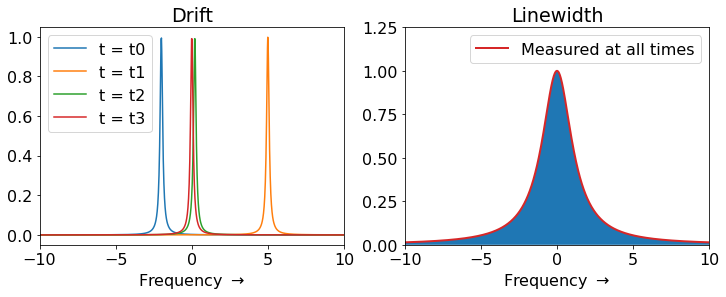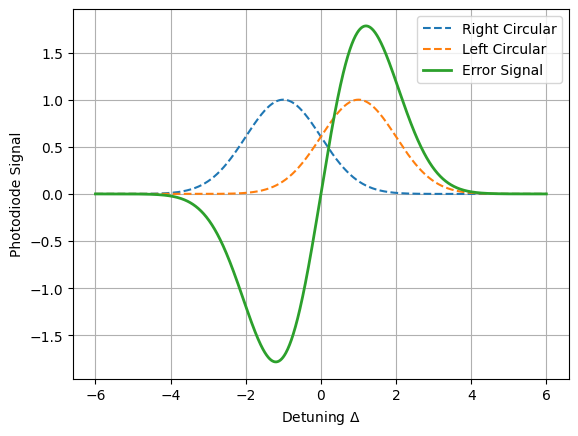Available Projects
!!In progress … will be updated next time we are waiting around for Digikey/ThorLabs parts to arrive!!
The big picture goals described in the Research page are broken down into man bite-sized subprojects that can be tackled individually.
Quantification of Laser Linewidth.
TDLR:
We need to develop a method to quickly and accurately measure a laser’s linewidth.
Overview:
Lasers can operate in either single-mode or multi-mode operation. Here “mode” means longitudinal modes of the laser cavity, and each mode corresponds to a particular frequency. For all of our experiments and indeed, for nearly all experimental setups, we require single mode operation. Although a laser is a nearly monochromatic (single frequency) source of light compared to many conventional light sources, its frequency is not precisely constant but has a (hopefully) small time dependence. When this drift in frequency is slow as compared to the time scales of our measurements (milliseconds or more) it is usually called “drift” and it appears that the laser’s frequency is moving around some central value f0. On the other hand, if it is much shorter than the time scales in question, these frequencies are smeared out together and it appears that the laser emits a continuum of frequencies over a given range of frequencies, centered on some central frequency f0.

There are several approaches to measuring the laser linewidth. We would like to try a few of these to make sure that the results are consistent:
-
Observing the beat note between two lasers on a spectrum analyzer (described here. In this approach two lasers are interfered and the result beat not in the frequency domain is related to the linewidth of each laser.
-
Looking at amplitude modulation at the side of an absorption feature. (This is described here. Here the laser is centered at a region that has a known absorption slope so that a change in frequency is converted to a change in power. Thus we measure power fluctuations dP and then df = dP×(df/dP)
-
Self heterodyning via a long fiber. This is described here. In this approach, the laser is sent through a long delay line via an optical fiber and some math is done to get the linewidth. An immediate issue is that we haven’t a long fiber, but we may be able to borrow one.
Personnel:
This should be possible over the course of 2 months with 1-3 (ideally two) motivated undergraduate students working a few sessions per week.
Current Personnel:
Neelam Esmail
Ash Enefer
Dichroic-Atomic-Vapour Laser Lock
TDLR:
We need to lock our laser’s central frequency to that of Atomic Rubidium.
Overview:
Although our lasers are fairly monochromatic, they are perfectly centered on a given frequency (see the laser linewidth project). In many of our experiments we require the lasers to have very low drift over long time scales - specifically we need our lasers’ frequency to be precisely tuned to a resonant frequency of our Rb atoms. By monitoring the deviation from this transistion we can employ feedback to provide a real time correction to laser linewidth.
In order to get a useable feedback signal for correcting the deviation from resonancem it is usefull to use a “zero-crossing” signal, that is positive on one side of the correct frequency and negative on the other. This is where the DAVLL comes in. The Dichroic-Atomic Vapour Laser Lock operates on the principle that a vapour of alkali atoms in a static magnetic field will experience circular dichroism - that is, right-handed circularly polarized light will be absorbed at a different frequency that lef-handed circular polarization. By placing a magnetic field around the atoms and monitoring the difference in transmission between right and left circular polarization, an error signal approximately proportional to the deviation from resonance is formed:

We have alread constructed an oven that provides such a magnetic field, based on the design of McCarron et al. We now need to employ a suitable feedback loop to the piezo of our selfmade lasers, and optimize the stability and performance of the lock.
Personnel Requirements:
We require 1-2 students over the course of 6-10 weeks.
Current Personnel:
Owen Sandner
Fiber Coupling Our ECDLs
TDLR:
Overview:
Personnel:
Current Personnel:
Optical Phase Locked Loop
TDLR:
Overview:
Personnel:
Current Personnel:
Spectroscopy Oven
TDLR:
Overview:
Personnel:
Current Personnel:
Spinning Waveplate Polarimeter
TDLR:
Overview:
Personnel:
Current Personnel: